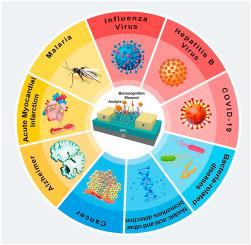Trends in Analytical Chemistry ( IF 11.8 ) Pub Date : 2020-10-09 , DOI: 10.1016/j.trac.2020.116067 Deniz Sadighbayan 1, 2 , Mohammad Hasanzadeh 2 , Ebrahim Ghafar-Zadeh 1, 3

|
The use of field-Effect-Transistor (FET) type biosensing arrangements has been highlighted by researchers in the field of early biomarker detection and drug screening. Their non-metalized gate dielectrics that are exposed to an electrolyte solution cover the semiconductor material and actively transduce the biological changes on the surface. The efficiency of these novel devices in detecting different biomolecular analytes in a real-time, highly precise, specific, and label-free manner has been validated by numerous research studies. Considerable progress has been attained in designing FET devices, especially for biomedical diagnosis and cell-based assays in the past few decades. The exceptional electronic properties, compactness, and scalability of these novel tools are very desirable for designing rapid, label-free, and mass detection of biomolecules. With the incorporation of nanotechnology, the performance of biosensors based on FET boosts significantly, particularly, employment of nanomaterials such as graphene, metal nanoparticles, single and multi-walled carbon nanotubes, nanorods, and nanowires. Besides, their commercial availability, and high-quality production on a large-scale, turn them to be one of the most preferred sensing and screening platforms. This review presents the basic structural setup and working principle of different types of FET devices. We also focused on the latest progression regarding the use of FET biosensors for the recognition of viruses such as, recently emerged COVID-19, Influenza, Hepatitis B Virus, protein biomarkers, nucleic acids, bacteria, cells, and various ions. Additionally, an outline of the development of FET sensors for investigations related to drug development and the cellular investigation is also presented. Some technical strategies for enhancing the sensitivity and selectivity of detection in these devices are addressed as well. However, there are still certain challenges which are remained unaddressed concerning the performance and clinical use of transistor-based point-of-care (POC) instruments; accordingly, expectations about their future improvement for biosensing and cellular studies are argued at the end of this review.
中文翻译:

基于场效应晶体管 (FET) 的生物传感:最新进展和挑战
早期生物标志物检测和药物筛选领域的研究人员强调了场效应晶体管(FET)型生物传感装置的使用。它们的非金属化栅极电介质暴露在电解质溶液中,覆盖半导体材料并主动传导表面的生物变化。这些新型设备以实时、高精度、特异性和无标记的方式检测不同生物分子分析物的效率已得到大量研究的验证。过去几十年来,FET 器件的设计取得了长足的进步,特别是在生物医学诊断和细胞分析方面。这些新颖工具卓越的电子特性、紧凑性和可扩展性非常适合设计快速、无标记和大规模的生物分子检测。随着纳米技术的结合,基于FET的生物传感器的性能显着提高,特别是石墨烯、金属纳米粒子、单壁和多壁碳纳米管、纳米棒和纳米线等纳米材料的使用。此外,它们的商业可用性和大规模的高质量生产使它们成为最受欢迎的传感和筛选平台之一。本综述介绍了不同类型 FET 器件的基本结构设置和工作原理。我们还重点关注了使用 FET 生物传感器识别病毒的最新进展,例如最近出现的 COVID-19、流感、乙型肝炎病毒、蛋白质生物标志物、核酸、细菌、细胞和各种离子。此外,还概述了用于药物开发和细胞研究相关研究的 FET 传感器的开发概况。还讨论了一些增强这些设备检测灵敏度和选择性的技术策略。然而,基于晶体管的护理点 (POC) 仪器的性能和临床使用仍然存在一些尚未解决的挑战;因此,在本综述的最后讨论了对其未来在生物传感和细胞研究方面的改进的期望。











































 京公网安备 11010802027423号
京公网安备 11010802027423号